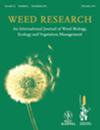光照、养分和土壤水分对 Arundo donax 的生长和资源分配的影响
IF 2.4
3区 农林科学
Q2 AGRONOMY
引用次数: 0
摘要
了解入侵物种如何应对非生物因素的变化,以及是什么因素影响了它们在新近受干扰地区定居的能力,对于预测物种扩张、确定管理工作的优先次序以及开发生态模型都很有必要。我们利用根茎碎片进行了一项全因子温室实验,研究四种养分水平、三种土壤湿度水平和两种光照水平(五个重复,n = 120)对大身形入侵湿地物种 Arundo donax 的生长和资源分配模式的影响。我们预测,在高光照、高土壤湿度和高养分条件下,旱金莲的表现相关性状--直接影响个体功能和适应性的性状--如地上生物量(AGB)、地下生物量(BGB)、净光合作用和平均茎高--将是最高的,这是因为侵略性入侵物种有能力利用更多的资源可用性。利用一般线性混合效应模型进行的分析表明,土壤水分和光照之间存在显著的交互作用。在饱和、高光照条件下生长的植物表现出最高的性能相关性状值。然而,与预测相反,养分对这些性状的影响并不显著。多变量方差分析表明,养分确实会影响生物量分配模式,添加氮和磷的植物显示出更高的AGB:BGB和茎叶比。这项研究强调了唐蜡对养分添加的独特反应以及生物量分配模式的可塑性。通过了解入侵物种如何对常见的非生物因素做出反应,我们可以更好地预测其扩张情况,并确定管理工作的优先次序,例如重点关注上层低遮荫区域,同时也为生态模型的开发提供了重要信息。本文章由计算机程序翻译,如有差异,请以英文原文为准。
Influence of light, nutrients, and soil moisture on the growth and resource allocation of Arundo donax
Understanding how invasive species respond to changes in abiotic factors and what influences their ability to colonise newly disturbed areas is necessary to predict species expansion, prioritise management efforts, and develop ecological models. We conducted a fully factorial greenhouse experiment using rhizome fragments to examine the effects of four nutrients levels, three soil moisture levels, and two light levels (with five replicates, n = 120) on the growth and resource allocation patterns of Arundo donax, a large‐statured invasive wetland species. We predicted that A. donax's performance‐related traits—traits that directly influence the functionality and fitness of an individual—such as aboveground biomass (AGB), belowground biomass (BGB), net photosynthesis, and average stem height, would be highest under high light, high soil moisture and high nutrient conditions due to the ability of aggressive invasive species to capitalise on greater resource availability. Analyses using general linear mixed‐effects models revealed significant interactions between soil moisture and light. Plants grown in saturated, high light conditions exhibited the highest values for performance‐related traits. However, contrary to predictions, nutrients did not significantly influence these traits. Multivariate analysis of variance demonstrated that nutrients did influence biomass allocation patterns, with plants grown with added nitrogen and phosphorus displaying higher AGB:BGB and stem:leaf ratios. This research highlights A. donax's unique response to nutrient addition and the plasticity of biomass allocation patterns. By understanding how invasive species respond to common abiotic factors, we can better predict their expansion and prioritise management efforts, such as focusing on areas of low overstory shading, while also providing crucial information for ecological model development.
求助全文
通过发布文献求助,成功后即可免费获取论文全文。
去求助
来源期刊

Weed Research
农林科学-农艺学
CiteScore
4.30
自引率
0.00%
发文量
41
审稿时长
12-24 weeks
期刊介绍:
Weed Research is an international peer-reviewed journal that publishes topical and innovative papers on weed science, in the English language. Its aim is to publish the best weed science from around the globe and to be the journal of choice for weed science researchers. It is the official journal of the European Weed Research Society. Papers are taken on all aspects of weeds, defined as plants that impact adversely on economic, aesthetic or environmental aspects of any system. Topics include, amongst others, weed biology and control, herbicides, invasive plant species in all environments, population and spatial biology, modelling, genetics, biodiversity and parasitic plants. The journal welcomes submissions on work carried out in any part of the world.
 求助内容:
求助内容: 应助结果提醒方式:
应助结果提醒方式:


